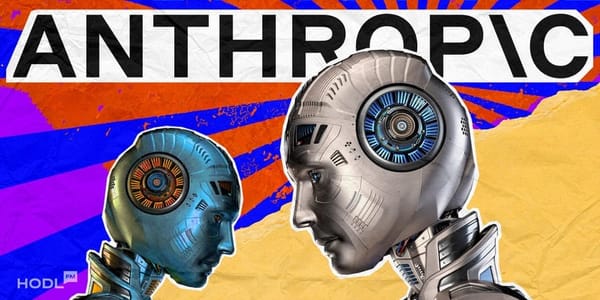Are you a crypto expert that can pinpoint the next “to-the-moon” project? Do you feel confident about your foresightedness? Yes? No? In either case, here is a question for you: where do you see crypto in ten years? We’re sure you have good answers. But in this article, we’ll explore eight forecasts for 2033, as predicted by none other than ChatGPT, your friendly neighborhood AI!
Grab your popcorn and let’s embark on this thrilling journey into the digital currency trends of the future with our AI companion. Naturally, the co-author of this article will be ChatGPT.

DeFi Expansion: The New Frontier of Finance
According to our AI friend, in 2033, Decentralized Finance (DeFi) will have revolutionized the financial landscape, leaving traditional banks scratching their heads in disbelief, and it has good reason for it too.
ChatGPT predicts this based on the current trajectory of DeFi, with its exponential growth and the increasing amount of value locked in decentralized protocols. Notable DeFi projects like Aave, Compound, and MakerDAO have gained significant traction, demonstrating the demand for decentralized lending and borrowing services. This supports the prediction that smart contracts will automate lending and borrowing on the blockchain, enabling individuals to secure loans without traditional banks.
New Technological Innovations: Unleashing the Blockchain Powerhouse
By 2033, the blockchain will have evolved into an unstoppable force, integrating itself into every aspect of our lives. ChatGPT’s evidence for this prediction lies in the ongoing research and development efforts in the blockchain space. Projects like Polkadot and Cosmos are working on interoperability solutions that allow different blockchain networks to communicate and share information seamlessly. These advancements pave the way for a future where assets can move fluidly across multiple chains, supporting the forecasted integration of blockchain technology into various industries.
Sustainability: Greening the Digital Revolution
As concerns about environmental sustainability grow, the crypto community will step up its game. ChatGPT predicts a significant shift towards sustainable mining practices based on the increasing awareness of the environmental impact of traditional mining operations. Concrete evidence for this trend can be seen in initiatives like the Crypto Climate Accord, which aims to decarbonize the cryptocurrency industry. Furthermore, countries such as Iceland and Sweden have already embraced renewable energy sources for crypto mining, indicating the viability and adoption of sustainable practices in the future.
When you think about it, even the shift to Proof-of-Stake from Proof-of-Work is a huge step forward in terms of sustainability. It’s hard to disagree with ChatGPT on that one, isn’t it?
Blockchain Adoption: The Masses Join the Party
In 2033, blockchain technology will no longer be a niche domain for tech-savvy enthusiasts. This prediction is supported by the increasing adoption of blockchain in various sectors. Governments around the world, including Estonia and Singapore, have implemented blockchain-based solutions for identity management and digital governance, showcasing the potential of blockchain beyond cryptocurrencies. Additionally, major companies like IBM and Walmart have successfully utilized blockchain for supply chain transparency. These real-world use cases provide evidence for the widespread adoption of blockchain technology by governments, educational institutions, and businesses.
To take this a step further, we can even foresee that not only tech-savvy enthusiasts but also your average Joe type of users will engage more with crypto and blockchain-related systems as a result of increased interaction with financial systems, which brings us to our next forecast.
Read also Elon Musk Signs Contentious “Pause AI Experiments-Open Letter” to AI Labs
Financial Services Interaction: The Rise of Hybrid Solutions
Traditional financial institutions will finally acknowledge the potential of cryptocurrencies and decentralized systems. Evidence for this prediction can be observed in the growing interest of banks and financial institutions in crypto-related services. For instance, JPMorgan Chase has launched its own stablecoin, JPM Coin, while Fidelity Investments has established Fidelity Digital Assets, offering custodial and trading services for digital assets. This shift indicates that traditional financial players are recognizing the importance of integrating crypto capabilities to cater to the changing preferences of customers.
Increased Institutional Investment: Wall Street Goes Crypto
Wall Street will have shed its skepticism and dived headfirst into the crypto market by 2033. Concrete evidence for this prediction can be found in recent developments such as the entry of major financial institutions into the crypto space. For example, prominent investment firms like Grayscale and MicroStrategy have allocated substantial amounts of capital into cryptocurrencies like Bitcoin. Additionally, the approval of Bitcoin futures contracts by the U.S. Commodity Futures Trading Commission (CFTC) has opened the doors for institutional investors to participate in the crypto market. These actions demonstrate a growing acceptance of cryptocurrencies as a legitimate asset class, supporting the prediction of increased institutional investment in the future.
This basically means that the suit-wearing, arrogant-looking Wall Street broker stereotype will change too!
Advanced Regulatory Framework: Clearing the Crypto Confusion
Regulation and crypto couldn’t get along well thus far, but, according to our AI buddy, they will find a way to co-exist in harmony.
As the crypto market expands, regulatory bodies will step up their game to provide a robust framework. Concrete evidence for this prediction can be seen in the global efforts to establish clearer regulations for cryptocurrencies. Countries like Switzerland, Singapore, and the United States have made significant strides in developing regulatory frameworks that balance innovation and consumer protection. The Financial Action Task Force (FATF), an intergovernmental organization, has also released guidelines for anti-money laundering and counter-terrorism financing measures in the crypto industry. These initiatives indicate a growing recognition of the need for comprehensive regulations to address the unique challenges posed by cryptocurrencies.
Greater Mainstream Adoption: Crypto Becomes a Way of Life
In 2033, cryptocurrencies will become a part of our daily lives, seamlessly integrated into everyday tasks. Evidence for this prediction can be found in the increasing acceptance of cryptocurrencies by merchants and service providers. Companies like Microsoft, PayPal, and Shopify already allow customers to make purchases using cryptocurrencies. Additionally, the emergence of cryptocurrency payment processors and debit cards further supports the forecasted mainstream adoption of digital currencies for everyday transactions. As more businesses recognize the benefits of accepting cryptocurrencies, their integration into our daily lives will become more prevalent.
Conclusion
As anybody with enough free time and a decent internet connection would do, we too enjoy having a casual chat with the famous ChatGPT. While it falls short of predicting the next “to-the-moon” projects, it certainly has some good insight into crypto and our expectations from it.
The future of cryptocurrencies looks incredibly promising based on ChatGPT’s predictions for 2033. We are on the brink of a DeFi revolution, and it is nice to see that unbiased artificial intelligence thinks the way we do! With new technological innovations, sustainability initiatives, and increased institutional investment, the crypto market is set to soar to new heights.
Moreover, as mainstream adoption takes hold and advanced regulatory frameworks provide stability, cryptocurrencies will become an integral part of our daily lives. We will witness a world where blockchain technology seamlessly integrates into various sectors, enhancing efficiency, transparency, and security.
The crypto futures of 2033 hold the promise of a decentralized and inclusive financial system, where individuals have greater control over their assets and the global economy operates with newfound efficiency Remember, this article is a glimpse into the future, based on predictions by ChatGPT. While we can’t guarantee the accuracy of these forecasts, they provide a fascinating perspective on the potential developments in the crypto space. Do you agree with ChatGPT?




